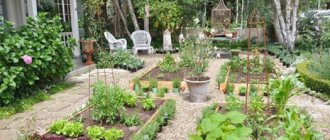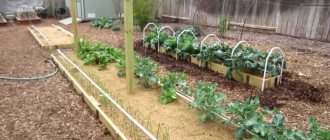Garden for the lazy
The dacha was created for recreation and as a utility plot with agricultural products. Most often you have to work there yourself, spending time getting there and clearing it of weeds. But the laziest summer resident is capable of not only beautifully decorating a garden with a vegetable garden, but also getting a harvest without much work and daily watering.
If you know the manual on agricultural technology, it is easy to do without unnecessary hassle and investment, which often does not make sense. The average dacha, even in summer, is visited approximately two days a week, so before the start of the holiday season you should properly plan your vegetable garden so as not to spend the whole summer in the garden beds.
What lazy summer residents don’t do:
- dig continuously;
- loosen the soil after rain;
- water and weed constantly;
- use pesticides.
The soil is partially cultivated, not completely. Individual places are mulched and collective plantings or re-seedings are organized. Experienced gardeners use green manure for picking. This option for landscaping a suburban area is suitable for both beginners and advanced gardeners.
Raised beds are the key to success
It is better to grow salads and vegetables using a high bed. Crops that require frequent attention are much more convenient to maintain in such beds. High beds heat up faster, which means planting can be done early, and the presence of a mesh at the base will protect the plants from the invasion of moles. Read about designing beds: “Beautiful and proper vegetable garden at the dacha with your own hands - photos, interesting ideas for designing beds”
You should not build a large bed; its frame can be no more than 1.5 meters wide. In this case, you can cultivate the land while standing to the side of the planting. Besides:
- A raised bed can be turned into a greenhouse. To do this, it is advisable to divide it in half lengthwise and secure a film over each part.
- The height of the compost bed can reach up to 100cm. Of course, she will have to be protected. For this you can use boards, logs, bricks, stones. An added bonus: this type of fencing will give your garden beds a neat appearance.
- It is highly desirable to equip the raised beds of a smart garden with a built-in irrigation system. This can be the root or drip method. Read about organizing irrigation: “Do-it-yourself automatic watering of a plot and lawn, design and diagram of an automatic watering system in a dacha”, “Drip irrigation of cucumbers in a greenhouse from a drip and plastic bottles - how to do it yourself?”
Raised beds make it easier to care for and decorate the area
Vegetable garden layout
The lazy ranch is decorated with ornamental plants that are best adapted to the given environment. Flowers, shrubs, and trees that require painstaking care and that often have to be trimmed are excluded. Picturesque “Dutch” dachas require constant work, so it is better to abandon them, although they are beautiful.
In the recreation area there is usually a barbecue grill, a barbecue grill or a fireplace, benches or chairs nearby, and if there are children, a place is allocated for their games. The main thing is to try not to damage cultivated plants. The gazebo is placed on a convenient, level place. All flower beds and areas with barbecues are sprinkled with coarse sand, pebbles, and covered with medium boulders. Vertical gardening is organized around the gazebo, private house, along the fence, but it should not shade the vegetables.
A lawn is a must for lazy coziness. It is better to purchase it, put it in rolls - it will take root in 10-15 days and will be ready for use. But this option is relatively expensive, especially when it comes to large spaces. You can sow your lawn yourself using fescue, ryegrass, bluegrass, bentgrass, sedum, and clover, mowing it periodically. It will become thick in a year, so it is better to sow grass for the winter.
The paths are sprinkled with gravel, sand, pebbles, and laid with tiles. The thicker and denser the layer, the less likely it is that the paths will become overgrown. Their edges can be reinforced with curbs so that the coating is not washed away by rain.
The beds are made ordinary, high, limited. Standard ones are arranged at soil level; on narrow ones, plants grow in one row, their surface rises 15-20 cm above the ground; tall ones require a frame made of vines and other materials. A fertile soil mixture is poured into a wooden box, which dries out less in the heat. Such a garden can be made along the perimeter of the site, freeing up the central part for relaxation.
What is better to plant?
Cultivated plants are selected in accordance with the conditions in a given region. If the area is cold, then heat-loving vegetables are immediately eliminated - some tomatoes, peppers, certain types of cucumbers, grapes. Building or covering a greenhouse for them every year is quite a task.
Exotic plants are also not always acceptable - in the summer they feel good, but in the winter they freeze thoroughly and die without proper insulation. To reduce hassle, varieties are selected that not only grow well, but are also quite resistant to pests and diseases. It is unlikely that it will be possible to do without treatment completely, but working hard 1-2 times a season is acceptable.
It is also important to take into account the condition of the soil - excessively saline places, sandy soil, where no fertilizers have been applied for 2-3 years, will not allow plants to fully develop. They will turn yellow and dry out, so you should choose the most durable ones. Harmful insects easily move from one area to another if there is food for them there, and can also be brought in from neighbors.
Useful crops
Some types of flowers can repel the most common insects.
- Marigolds - secrete phytoncides, removing various worms from tomatoes, potatoes, strawberries are saved from weevils, legumes from aphids, onions from flies, cabbage from moths;
- Tansy drives away the Colorado potato beetle, white beetle, copperhead, moth, mite, and codling moth;
- calendula protects from the Colorado potato beetle, strawberries from aphids, suppresses various types of caterpillars, and saves from fungi;
- pyrethrum (chamomile) destroys flies, fleas, ants, cockroaches, lice, mosquitoes, aphids, spiders, caterpillars, nematodes, repels rodents;
- nasturtium gets rid of whitefly, whitefly, late blight;
- geranium saves from aphids and flies;
- petunia protects legumes from pests, radishes and turnips from cruciferous flea beetle, aster from fusarium;
- lavender saves from moths, ants, slugs, aphids;
- a lemon tree will get rid of mosquitoes, although its fruits will not have time to ripen in a cold climate.
The flowers described above are planted around the perimeter of the beds or spot-wise - in the middle, in the corners.
A metal mesh with small cells dug 40-60 cm deep will save moles from entering the area. It should protrude 18-25 cm above the ground. It is important to dig it along the entire perimeter where it was decided not to allow moles. If they do get in, it’s worth periodically bringing in a cat or dog that can catch them.
Trees and bushes cause a minimum of trouble - honeysuckle, rowan, lilac, lemongrass, serviceberry, hops, various conifers. Echinacea and clematis are planted from flowers. You can plant wild grapes, but they need to be pruned periodically, which takes some time. Perennial flowers often begin to bloom only in the second year.
Caring for gardening plantings
Plants should not interfere with each other - different crops should be planted so that they do not shade the beds. It is necessary to take into account the relief: tomatoes, peppers, cucumbers, eggplants are planted on the hills, cabbage, carrots, beets, radishes, pumpkins, and potatoes are planted below. The beds are often made rectangular or round, decorated with borders made of boards, leftover slate, metal, and brick.
Sunflowers and corn are planted along the perimeter of the fence if the climate is warm enough. Maintenance is the simplest - watering, fertilizing, weeding, and sometimes loosening. You need to be prepared for the fact that in the summer, especially at high temperatures and humidity, the garden will quickly become overgrown - it will take a long time to weed.
This is where mulching comes to the rescue. During this procedure, the rows and holes are covered with sawdust, green manure, mown grass, straw, hay, peat, bark, wood chips, leaf humus, and fallen pine needles. Also often used are special films, non-woven materials, paper, stones, and expanded clay. This procedure not only eliminates the need for frequent weeding, but also warms the roots of plants in cold weather and saves the soil from drying out in hot weather.
Many people water their gardens with hoses with diffusers, watering cans, and buckets. There are options with drainage, but only for raised beds. The best way is drip irrigation. The main pipe of the required diameter and length is brought to the site. One end is secured to the tap, a plug is placed on the other.
Next, wiring is done at the row level, a nipple with tape is added. The pressure can be adjusted. The result is that the drops fall evenly onto the ground, moistening it. There is no need to run around with a bucket anymore. The tape is removed for the winter. As an option, tubes from a dropper are attached to the water hose in the right places. The amount of moisture is also adjustable.
You don’t need a lot of garden tools: a shovel, a bucket, a watering can, a rake, a pruning shears, sometimes you will need a hoe, a flat cutter, a hoe. Its quantity should also be considered, especially if the dacha is large and several people are going to work on it. They don’t skimp on tools - a plastic one won’t last long, and one that’s too heavy will quickly tire you out.
At the purchasing stage, you should consider whether the tool is the right length, whether the handle is comfortable, and whether it holds well. All items are chosen in bright colors - this makes them easier to find in thick grass and bushes. Tools should be stored where they will not be stolen by country thieves.
Correct proximity of plants
Allelopathy is the ability of individual specimens to secrete substances that have a detrimental effect on others and seriously inhibit their growth. Also, many are able to suck nutrients from the ground, leaving nothing for others. Not all vegetables, berries, and fruit trees can coexist normally with each other:
- cabbage does not get along with wild strawberries;
- beans of any kind - with onion vegetables;
- carrots - with dill, parsley, celery;
- potatoes with cucumber;
- eggplant with fennel, peas;
- melon with potatoes;
- apple tree with cherries, currants;
- red currants with raspberries;
- strawberries with raspberries, sea buckthorn;
- gooseberry with apple tree;
- plum with pear, cherry.
What can be planted in the same bed or in close proximity:
- with carrots - peas, tomatoes, sage, onions;
- next to strawberries - lettuce, arugula, spinach, marigolds, garlic, beans;
- with kohlrabi cabbage - cucumbers, beets, turnips;
- along with peas - eggplants, carrots, corn, calendula;
- with onions - tomatoes, celery, thyme, beets;
- next to beans - potatoes, eggplant, tomatoes;
- with cucumber - peppers, radishes, beans, peas, cabbage;
- together with salad - wild strawberries, strawberries, carrots;
- with pepper - arugula;
- next to the tomatoes - basil, nasturtium, parsley, calendula;
- with beans - potatoes, savory;
- along with eggplants - onions, peppers;
- with mustard – Brussels sprouts, white cabbage, kohlrabi, radish;
- next to garlic - peas, beans;
- with grapes - cherries;
- together with cherries - pear, plum, apple tree;
- with strawberries - garlic, parsley;
- next to the raspberries - an apple tree, a plum tree;
- with gooseberries - red currants, cherries.
They can grow well with any neighbors: daikon, zucchini, Sarepta mustard, kale and savoy cabbage, kruknek, lagenaria, squash, leeks, capsicums, rhubarb, turnips, seed lettuce, medicinal asparagus, pumpkin, horseradish, chicory.
If you plant different plants in the beds every year, following a certain order, the harvest will also be higher. Options:
- in the first year they plant fruit crops, in the 2nd year - root crops, in the 3rd year - legumes;
- 1 – leafy, 2 – fruit, 3 – root.
This is how correct crop rotation occurs. Vegetables include cabbage, all salads, spinach; fruits include tomatoes, eggplants, peppers, pumpkin; legumes include beans, peas, chickpeas; root vegetables include beets, turnips, radishes, carrots, and potatoes.
Some tricks
The technology is called smart gardening for a reason. You can test different approaches, new products, and the experience of “colleagues.” There are several tricks that come with use. We have already talked about one - about covering material. It really makes maintenance a lot easier and there is no need for mulch. There are other interesting ideas:
- After crops that are “heavy” for the soil, sow oats, peas, mustard, and rapeseed. After a couple of weeks, juicy greenery grows. It can be left “under the snow” and dug up in the spring. Or dig it up just before the snow, along with the greens. The goal here is twofold - the young greenery rots, enriching the earth. This time. And two - weeds do not grow, since the shoots are friendly.
This harvest makes my heart happy
- Use white covering material to extend the summer season and get an early harvest. Arcs are made from steel rod with a diameter of 8-10 mm. Drawstrings 2 cm wide or more are sewn into medium or high density spunbond. Arcs are inserted into them, spunbond is assembled on the wire so that the ends of the wire are free. The portable mini-greenhouse is ready. Stick arcs in at both ends of the bed. To protect the plants from frost, straighten the spunbond; you can open it for the day by collecting all the material on one side. The same design will also save you from overheating in the summer heat.
- Place a large metal barrel in the corner of the site. Place weeds and other plant waste in it. To fill with water. The greens will quickly rot and this slurry can be used for feeding. You just need to cover the barrel - the contents don't smell the best.
Surely there are still tricks in processing a smart vegetable garden. If we find out about them, we will definitely update the article.
The best posts
- Which wallpaper is better, vinyl or non-woven: what is the difference, the difference, can it be glued with vinyl glue, which one to choose, video
- Guide to building a frame house structure with your own hands
- Features of the selection and installation of the Mayevsky crane
- Shower cabin with deep tray
- Modular sofa for living room with sleeper
- We knit an umbrella for an amigurumi doll
- How can you save money when decorating your bathroom?
- Can I wash with hand wash powder in a machine?
Article on the topic: Accessories for curtains: types and features of auxiliary products
Decoration of the cottage
There are many planning styles, but it makes sense to beautifully arrange the site if there is water and at least minimal security. The lazy area is usually decorated with purchased items - a gazebo, a false well. But it costs money, and I’m too lazy to make something exquisite myself.
For example, country music is created from simple materials; there will be a garden, a vegetable garden, or a cozy place to relax. It’s easy to make a couple of gnome idols by drawing faces on logs, pulling on old hats, and tying scarves. For children, a wooden swing is made from a board attached to a hemp so that it dangles. The hammock is pulled between the fence posts if it is strong enough or there are large trees.
If necessary, the table is made from any hemp with a board nailed to it, chairs are also made from hemp, and sometimes backs are made for them. Garden paths are laid from wood cuts of various diameters with a thickness of 2-4 cm.
For the industrial style, any old trash is also suitable. A lake with swans is made from a piece of tarpaulin and a pair of tires. The tires are cut and painted white. An old bicycle, motorcycle, car frame is planted around with brightly flowering climbing plants, creating an unusual flower bed. The beds are fenced with rows of colored bottles. Plastic palm trees and Christmas trees are often made from them.
Japanese style is decorated with stones. They clearly separate the garden from the recreation area; the flower beds are alpine hills with field herbs or cultivated plants. If you manage to find a large flat stone, they arrange a table on it, with seats around it. On the playground they paint in various shades or patterns in the form of animals - beetles, frogs, lizards, crocodiles, snakes, snails.
A homemade swing made from a plank with ropes threaded through its holes will delight children and adults. They are mounted on a special stand or large tree. Such a frame with round pebbles poured into it will make a stand for washing your feet when entering the house - a hose or buckets of water are placed nearby. The area around the country house is decorated with colorful plastic lids, which are attached to concrete or clay.
Recommendations and advice for gardeners
In order to save as much energy and time as possible on caring for a summer cottage, beginners in gardening should follow simple recommendations. The beds do not need to be dug deep if the soil is well fertilized, rich in humus, has a certain fertile layer, dig it 5-7 cm deep.
Before sowing seeds for seedlings, it is advisable to calculate how many fruits and vegetables you need. Those who plant the land completely sometimes do not assume that some of the produce will then lie unnecessarily and deteriorate. Before planting plants that are planted late, you can sow oats - it will make the ground soft and create material for mulching;
Pots, boxes, vertical flower beds are not very convenient; here they often need to be replanted, watered, and fertilized. Only ready-made seedlings are taken to the dacha - purchased or grown on the windowsill.
It is not necessary to dig up the entire area for the winter, only the part where there will be beds or some kind of garden design. Leveling large spaces is extremely labor-intensive. Box-shaped 300-400 by 90-100 cm are best suited. They should be dug to the depth of a bayonet or a little deeper. Tall ones are made from halves of wooden or plastic barrels, 2-3 tires fastened to each other. Climbing plants such as sweet peas, morning glory, grapes, green beans, peas, and zucchini are placed along a large mesh attached to a stand.
The area under trees and bushes is mulched with non-woven material, and sawdust or gravel is poured on top. If the harvest is harvested early, the beds are not left empty - radishes, lettuce, dill, radishes, peas, mustard, and buckwheat are planted on them. For the winter, it is better to cover the garden for the lazy with straw, mown grass (without seeds), fallen leaves, and vegetable tops.
Secrets of a lazy gardener
Any gardener dreams of a rich harvest, without excessive effort and exhausting physical labor. Such gardeners have come up with several simple secrets that simplify country life.
Tips for simplifying summer cottage work:
- Do not dig up beds with shovels or pitchforks. The easiest way to loosen the soil is to use a flat cutter. It will allow you to mix the earth layers a little without damaging their fertility.
- It is better to dig holes no wider than 1 meter and no deeper than 70 cm. Such dimensions will provide all plants with good nutrition with nutrients and active growth.
- The beds must be insulated. To do this, you need to add several layers of various fertilizers (wood + ash, compost + ash, food residues) to the excavated soil.
Interestingly, regularly adding food scraps to the soil, such as orange peel or eggshells, increases the temperature underground by about 5 degrees, compared to neighboring beds.











